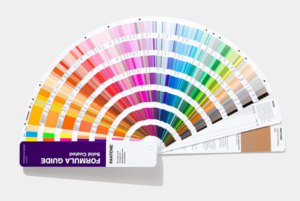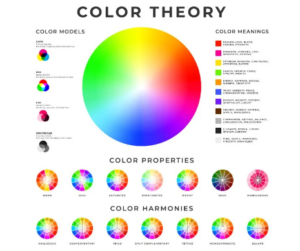Color theory is a fundamental concept in design, crucial for creating visually appealing and effective compositions. Understanding how colors interact, complement, and influence each other allows designers to craft harmonious and impact visuals.
Whether you’re a graphic designer, an interior decorator, or simply someone interested in design, mastering color theory can enhance your work and decision-making process.
This guide will delve into the core principles of color theory, its benefits, and practical applications, along with recommended tools and resources to help you apply these concepts effectively.
The Fundamentals of Color Theory
Color theory is based on the science of how colors interact with each other and how they can be used to create different effects. The theory encompasses a range of concepts, including color wheels, color harmony, and the psychological impact of colors.
Color Wheel Basics
The color wheel is a fundamental tool in color theory. It visually represents the relationships between colors and is divided into primary, secondary, and tertiary colors.
- Primary Colors: Red, blue, and yellow are the building blocks of all other colors. They cannot be created by mixing other colors.
- Secondary Colors: Orange, green, and purple are formed by mixing two primary colors.
- Tertiary Colors: These are created by mixing a primary color with a secondary color, resulting in hues like red-orange and blue-green.
Understanding the color wheel helps designers select color schemes that are visually appealing and balanced.
Color Harmony and Schemes
Color harmony refers to the aesthetically pleasing arrangement of colors. Different color schemes can be used to achieve various effects:
- Complementary Colors: Colors opposite each other on the color wheel, such as blue and orange, create high contrast and vibrant effects.
- Analogous Colors: Colors next to each other on the wheel, like blue, blue-green, and green, create a harmonious and serene look.
- Triadic Colors: Three colors evenly spaced around the wheel, like red, yellow, and blue, provide a balanced and vibrant color scheme.
Benefits of Applying Color Theory
Enhanced Visual Appeal
Applying color theory principles helps create visually appealing designs. By understanding how colors interact, designers can create harmonious and aesthetically pleasing compositions that attract and hold viewers’ attention.
Effective Communication
Colors can convey different emotions and messages. For example, blue often represents calm and professionalism, while red can evoke excitement or urgency. Using color theory, designers can choose colors that effectively communicate the desired message or emotion.
Improved User Experience
In user interface design, color theory helps ensure that elements are easy to distinguish and interact with. Proper color choices can enhance readability, usability, and overall user experience.
Practical Applications and Tools
Product Name: Adobe Color CC

Description: Adobe Color CC is a powerful tool for creating and exploring color schemes based on color theory principles. It allows users to generate color palettes, explore color harmonies, and apply them to design projects.
- Use Case: Ideal for graphic designers and digital artists looking to create cohesive and harmonious color schemes.
- Pros: Easy to use, integrates with other Adobe Creative Cloud tools.
- Cons: Requires a subscription to Adobe Creative Cloud.
- Price: Subscription-based; pricing varies depending on the plan.
- Features: Color wheel, color harmony rules, palette sharing.
Where to Buy: Get Adobe Color CC
Product Name: Pantone Color Guide

Description: The Pantone Color Guide provides a comprehensive collection of color swatches and is essential for print and product designers. It helps ensure color accuracy and consistency across different media.
- Use Case: Best for print designers and manufacturers needing precise color matching.
- Pros: Extensive range of colors, industry-standard for color accuracy.
- Cons: Can be expensive, requires periodic updates.
- Price: $150 – $200
- Features: Color swatches, color matching guides, color reference.
Where to Buy: Buy Pantone Color Guide – eBay
Product Name: Color Theory for Designers: Studio Series

Description: This book offers an in-depth exploration of color theory tailored for designers. It covers practical applications, color combinations, and case studies to help designers apply color theory effectively in their projects.
- Use Case: Useful for students, design professionals, and anyone looking to deepen their understanding of color theory.
- Pros: Comprehensive content, practical examples, easy to understand.
- Cons: Physical copy can be bulky; digital version might be more accessible.
- Price: $40 – $50
- Features: Detailed explanations, practical exercises, case studies.
Where to Buy: Purchase Color Theory for Designers – Linearity
How to Buy and Where to Buy
Where to Buy
You can purchase color theory tools and resources from various retailers and online platforms. Websites like Adobe, Pantone, and Amazon offer a range of products suitable for different needs and budgets.
How to Buy
When buying color theory resources:
- Assess Your Needs: Determine whether you need a digital tool, physical guide, or both.
- Check Reviews: Look for reviews and ratings to ensure the product meets your requirements.
- Compare Prices: Explore different sellers to find the best price.
FAQs
1. What is color theory and why is it important?
Color theory is the study of how colors interact and how they can be used effectively in design. It’s important because it helps create visually appealing and effective designs, communicates emotions and messages, and enhances user experience.
2. How can I apply color theory to my design projects?
To apply color theory, use tools like color wheels and color harmony guidelines to choose color schemes that work well together. Consider the psychological impact of colors and how they will be perceived by your audience.
3. What are some recommended tools for color theory?
Recommended tools include Adobe Color CC for digital color schemes, Pantone Color Guides for accurate color matching in print, and design books like “Color Theory for Designers” for in-depth understanding.